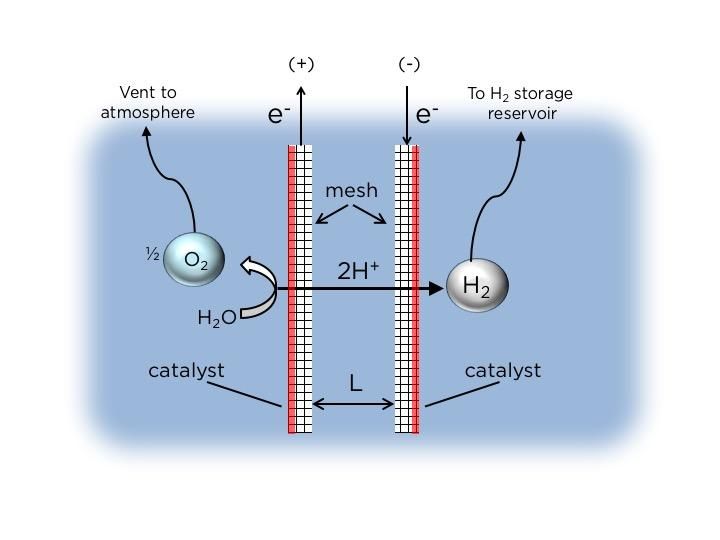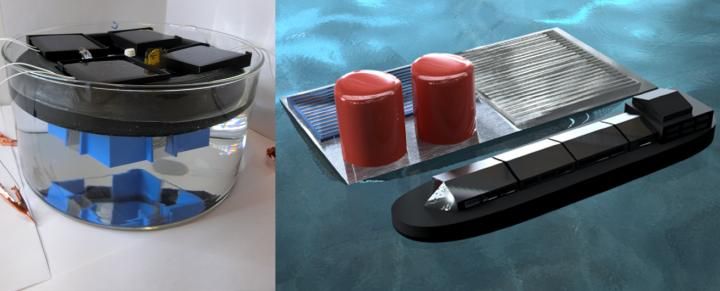Could Giant “Solar Rigs” Floating On the Ocean Convert Seawater To Hydrogen Fuel?
Scientists at Columbia University have designed a device that could make the process economically viable
/https://tf-cmsv2-smithsonianmag-media.s3.amazonaws.com/filer/32/7a/327a00dc-e0d2-44f7-8232-4dc2dde22054/ocean.jpg)
Usually, when we think about energy production at sea, we imagine giant oil rigs, or perhaps rows of towering wind turbines. Recently, though, floating solar panels have been added to the mix, including a solar farm the size of 160 football fields that went into operation in China last year.
Now, a team of researchers at Columbia University wants to go a step farther. They say it’s possible to use solar panels on the ocean surface to power devices that can produce hydrogen fuel from seawater.
Hydrogen is a clean form of energy, but it’s most commonly produced from natural gas in a process that also releases carbon dioxide, a key driver of climate change. The Columbia scientists say their device, called a floating photovoltaic electrolyzer, eliminates that consequence by instead utilizing electrolysis to separate oxygen and hydrogen in water molecules, and then storing the latter for use as fuel.
Team leader Daniel Esposito, an assistant professor of chemical engineering, points out that using existing commercial electrolyzers to generate hydrogen is pretty costly. “If you take off-the-shelf solar panels and commercially available electrolyzers, and you use sunlight to split water into hydrogen and oxygen, it’s going to be three to six times more expensive than if you were to produce hydrogen from natural gas,” he says.
He also notes that those electrolyzers require membranes to keep the oxygen and hydrogen molecules separated once they’re split apart. That not only adds to the cost, but those parts would tend to degrade quickly when exposed to the contaminants and microbes in saltwater.
“Being able to safely demonstrate a device that can perform electrolysis without a membrane brings us another step closer to making seawater electrolysis possible,” Jack Davis, a researcher and lead author of the proof-of-concept study, said in a statement. “These solar fuel generators are essentially artificial photosynthesis systems, doing the same thing that plants do with photosynthesis, so our device may open up all kinds of opportunities to generate clean, renewable energy.”

Bubbling up
So, what makes their electrolyzer distinctive?
The device is built around electrodes of titanium mesh suspended in water and separated by a small distance. When an electrical current is applied, the oxygen and hydrogen molecules split apart, with the former developing gas bubbles on the electrode that’s positively charged, and the latter doing the same on the one with a negative charge.
It’s critical to keep these different gas bubbles separated, and the Columbia electrolyzer does this through the application of a catalyst to only one side of each mesh component—the surface farthest away from the other electrode. When the bubbles get larger and detach from the mesh, they float up along the outside edges of each electrode instead of mixing together in the space between them.
Not only have the scientists avoided using expensive membranes, but they also didn’t have to incorporate the mechanical pumps that some models use to move liquids. Instead, their device relies on buoyancy to float the hydrogen bubbles up into a storage chamber. In the lab, the process was able to produce hydrogen gas with a 99 percent purity.
Alexander Orlov, an associate professor of materials science and chemical engineering at Stony Brook University in New York, agrees that the elimination of membranes is a "substantial" development. "The membranes are weak points in the technology," he says. "There are some more sophisticated solutions, but Esposito's approach is extremely simple and quite practical. It has been published and peer-reviewed in very high-impact publications, so despite its simplicity, the science and novelty are solid."
Thinking big
Esposito and Davis readily acknowledge that it’s a big leap from the small model tested in their lab to the massive kind of structure that could make the concept economically viable. It might need to comprise hundreds of thousands of connected electrolyzer units to generate a sufficient amount of hydrogen fuel from the sea.
In fact, says Esposito, it might be necessary to make some design changes as the project scales up and becomes more modular, so many pieces can fit together to cover a large area. Also, they face the challenge of finding materials that can survive for a long time in saltwater.
That said, both believe their approach has potential to affect the country’s energy supply in a meaningful way. Hydrogen already is heavily used in the chemical industry, for instance, to make ammonia and methanol. And, demand is expected to keep rising as more auto manufacturers commit to cars that run on hydrogen fuel cells.

Their long-term vision is of giant “solar fuel rigs” floating in the ocean, and Esposito has gone so far as to estimate how much cumulative area they would need to cover to generate enough hydrogen fuel to replace all the oil used on the planet. His calculation: 63,000 square miles, or an area slightly less than the state of Florida. That sounds like a lot of ocean, but he points out that the total area would cover about .045 percent of the Earth’s water surface.
It’s a bit of a pie-in-the-sky projection, but Esposito has also thought about the real-world challenges that would face a floating energy production operation not tethered to the sea bed. For starters, there are big waves.
“Certainly, we’d need to design the infrastructure for this rig so that it can withstand stormy seas,” he says. “It’s something you would take into account when you’re thinking where a rig is located.”
And maybe, he adds, these rigs could be able to move out of harm’s way.
“There’s the possibility of a rig like this being mobile. Something that could perhaps expand, and then contract. It probably wouldn’t be able to move fast, but it could move out of the way of a storm.
“That would be really valuable,” he says.
/https://tf-cmsv2-smithsonianmag-media.s3.amazonaws.com/accounts/headshot/randy-rieland-240.png)


/https://tf-cmsv2-smithsonianmag-media.s3.amazonaws.com/accounts/headshot/randy-rieland-240.png)